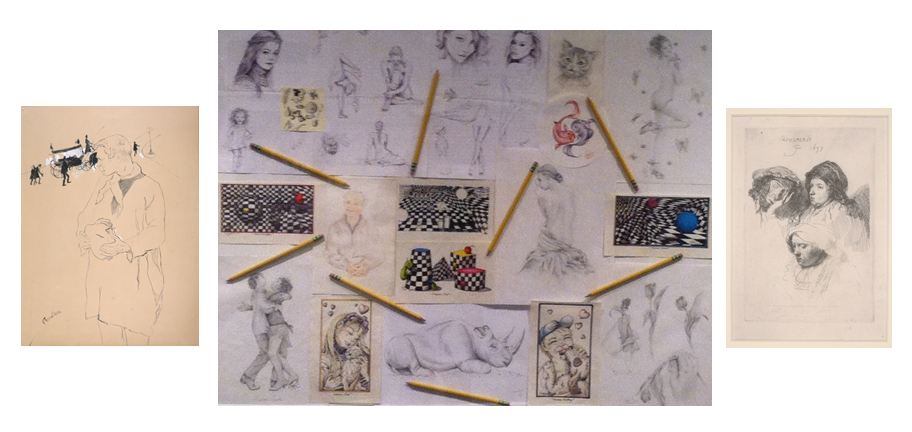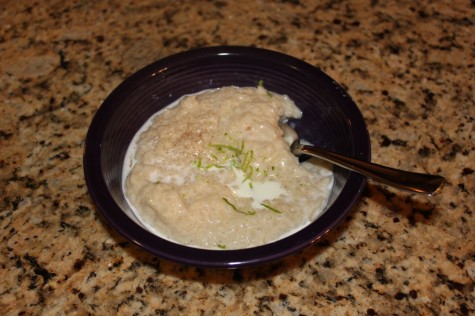Last Friday, the Dallas Museum of Art Staff celebrated the opening of a new show, Crawl Space: Within the Walls, which features works of art by our very own staff. Crawl Space turns the spotlight around onto those who make possible the other wonderful exhibitions on view here at the Museum. In this show, you will find a myriad of subjects and media by representatives from many of the DMA’s departments, from curators to grant writers to the gallery attendants who insure the safety of our collection.
I asked the participants to consider their pieces in relation to the DMA’s permanent collection by responding to the question: “If you could have your work installed next to something from the DMA, what would it be?” Here is a sampling of the responses:
 “I would love it if my two photographs could flank [Andrew Wyeth’s That Gentleman]. I believe the images all have similar tones that reflect stillness, reflection, and solitude.” – Reagan Duplisea, Associate Registrar for Exhibitions, 4 years at the DMA
“I would love it if my two photographs could flank [Andrew Wyeth’s That Gentleman]. I believe the images all have similar tones that reflect stillness, reflection, and solitude.” – Reagan Duplisea, Associate Registrar for Exhibitions, 4 years at the DMA
- Andrew Wyeth, That Gentleman, 1960, Dallas Museum of Art, Dallas Art Association Purchase.
- Reagan Duplisea, Ascendez (Tribute to Madame J, I), 2010
- Reagan Duplisea, Descendez (Tribute to Madame J, II), 2010.
“I would like to have Banquete Chair with Pandas installed next to my collages. My collages are playful and speak to 1950s consumer culture while the Campana chair does something similar with a 21st century sensibility. Also, both may be said to deal with the theme of animals run amuck.” – Dana Harper, Assistant Librarian, 4 years at the DMA.
- Dana Harper, Dream Kitchen #1, 2012.
- Fernando and Humberto Campana, Banquete Chair with Pandas, designed 2006, Dallas Museum of Art, DMA/amfAR Benefit Auction Fund.
- Dana Harper, Dream Kitchen #2, 2012.
 “I would love to see my painting, Garden of Earthlike Planet Delights, paired with this mask. The mask is primal, dark, mysterious, and speaks of danger and tribal ritual. I love listening to the big three Diaghilev-era Stravinsky ballets in sequence and on ‘repeat all’ while I paint. For me, it isn’t hard to imagine some faraway, earthlike, but strange world in our galaxy where there may exist primitive humanoid tribes experiencing life in ways similar to our own prehistoric times.” – David Caldwell, Gallery Attendant, 1 year at the DMA.
“I would love to see my painting, Garden of Earthlike Planet Delights, paired with this mask. The mask is primal, dark, mysterious, and speaks of danger and tribal ritual. I love listening to the big three Diaghilev-era Stravinsky ballets in sequence and on ‘repeat all’ while I paint. For me, it isn’t hard to imagine some faraway, earthlike, but strange world in our galaxy where there may exist primitive humanoid tribes experiencing life in ways similar to our own prehistoric times.” – David Caldwell, Gallery Attendant, 1 year at the DMA.
- David Caldwell, Garden of Earthlike Planet Delights, 2012.
- Northern New Caledonia, Mask, late 19th – early 20th century, Dallas Museum of Art, The Roberta Coke Camp Fund.
 “I would want my drawing to go next to Sir Winston Churchill’s Self-Portrait from the Reves Collection. It’s a very simple colored pencil drawing of a pig. I think my drawing (of my dog, Cooper) would have a lot of fun hanging out with Churchill’s drawing.” – Hayley Dyer, Teaching Specialist, 2 years at the DMA
“I would want my drawing to go next to Sir Winston Churchill’s Self-Portrait from the Reves Collection. It’s a very simple colored pencil drawing of a pig. I think my drawing (of my dog, Cooper) would have a lot of fun hanging out with Churchill’s drawing.” – Hayley Dyer, Teaching Specialist, 2 years at the DMA
- Winston Churchill, Self Portrait, Dallas Museum of Art, The Wendy and Emery Reves Collection.
- Hayley Dyer, Mon Petit Chien, 2012.
 “I have always been fascinated with using people as my subject matter, because from a simple gesture, expression, attire, or scene, there is almost always a story behind them.” – Kay Sims, Lead Security Supervisor, 15 years at the DMA
“I have always been fascinated with using people as my subject matter, because from a simple gesture, expression, attire, or scene, there is almost always a story behind them.” – Kay Sims, Lead Security Supervisor, 15 years at the DMA
- Henri de Toulouse-Lautrec, The Last Respects, 1887, Dallas Museum of Art, The Wendy and Emery Reves Collection.
- Kay Sims, Sketchy Doodles, 1989-2011.
- Rembrandt van Rijn, Three Heads of Women, One Asleep, 1637, Dallas Museum of Art, gift of Calvin J. Holmes.
 “If my piece, Tie Down Thoughts with a Culinary Flair, could be installed next to something from the DMA’s collection, I would imagine it flanked by Bruce Conner’s Knox and Robert Rauschenberg’s Night Hutch. Both of these artists layer found images and objects, resulting in a uniquely recontextualized composition. The layers range from subtle, delicate pieces of cloth referencing “hoarfrost” to attention-grabbing objects protruding from the surface of a chunky assemblage. The layers in my work are meant to mimic the inner layers of the subconscious and how they relate to our outward perceptions. Both of these artists have greatly influenced my understanding of creating a language through mixed-media.” – Nicole Norton, Visitor Services Assistant, 1 year at the DMA.
“If my piece, Tie Down Thoughts with a Culinary Flair, could be installed next to something from the DMA’s collection, I would imagine it flanked by Bruce Conner’s Knox and Robert Rauschenberg’s Night Hutch. Both of these artists layer found images and objects, resulting in a uniquely recontextualized composition. The layers range from subtle, delicate pieces of cloth referencing “hoarfrost” to attention-grabbing objects protruding from the surface of a chunky assemblage. The layers in my work are meant to mimic the inner layers of the subconscious and how they relate to our outward perceptions. Both of these artists have greatly influenced my understanding of creating a language through mixed-media.” – Nicole Norton, Visitor Services Assistant, 1 year at the DMA.
- Bruce Conner, Knox, 1963, Dallas Museum of Art, DMA/amfAR Benefit Auction Fund.
- Nicole Norton, Tie Down Thoughts with a Culinary Flair, 2012.
- Robert Rauschenberg, Night Hutch, 1976, Dallas Museum of Art, gift of the artist.
Crawl Space will remain on view through January 6, 2013 in the Mezzanine 2 hallway.
Alex Vargo
McDermott Intern for Gallery Teaching







































